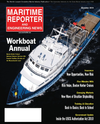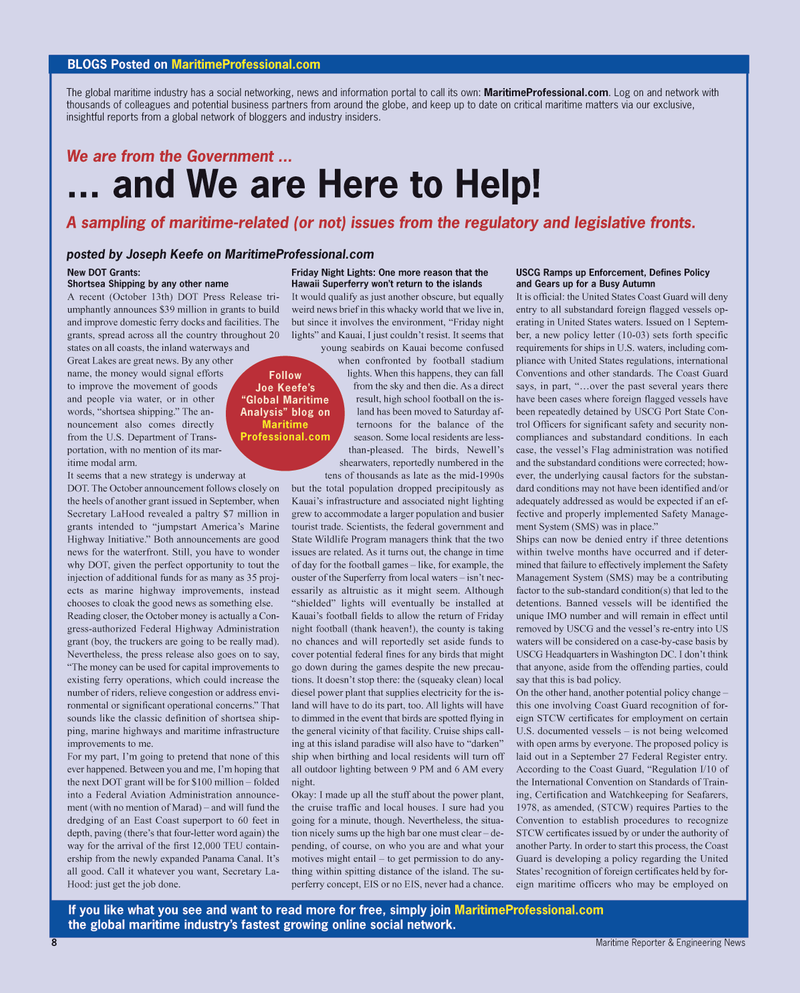
Page 8: of Maritime Reporter Magazine (November 2010)
Workboat Annual
Read this page in Pdf, Flash or Html5 edition of November 2010 Maritime Reporter Magazine
The global maritime industry has a social networking, news and information portal to call its own: MaritimeProfessional.com. Log on and network with thousands of colleagues and potential business partners from around the globe, and keep up to date on critical maritime matters via our exclusive, insightful reports from a global network of bloggers and industry insiders.
New DOT Grants:
Shortsea Shipping by any other name
A recent (October 13th) DOT Press Release tri- umphantly announces $39 million in grants to build and improve domestic ferry docks and facilities. The grants, spread across all the country throughout 20 states on all coasts, the inland waterways and
Great Lakes are great news. By any other name, the money would signal efforts to improve the movement of goods and people via water, or in other words, “shortsea shipping.” The an- nouncement also comes directly from the U.S. Department of Trans- portation, with no mention of its mar- itime modal arm.
It seems that a new strategy is underway at
DOT. The October announcement follows closely on the heels of another grant issued in September, when
Secretary LaHood revealed a paltry $7 million in grants intended to “jumpstart America’s Marine
Highway Initiative.” Both announcements are good news for the waterfront. Still, you have to wonder why DOT, given the perfect opportunity to tout the injection of additional funds for as many as 35 proj- ects as marine highway improvements, instead chooses to cloak the good news as something else.
Reading closer, the October money is actually a Con- gress-authorized Federal Highway Administration grant (boy, the truckers are going to be really mad).
Nevertheless, the press release also goes on to say, “The money can be used for capital improvements to existing ferry operations, which could increase the number of riders, relieve congestion or address envi- ronmental or significant operational concerns.” That sounds like the classic definition of shortsea ship- ping, marine highways and maritime infrastructure improvements to me.
For my part, I’m going to pretend that none of this ever happened. Between you and me, I’m hoping that the next DOT grant will be for $100 million – folded into a Federal Aviation Administration announce- ment (with no mention of Marad) – and will fund the dredging of an East Coast superport to 60 feet in depth, paving (there’s that four-letter word again) the way for the arrival of the first 12,000 TEU contain- ership from the newly expanded Panama Canal. It’s all good. Call it whatever you want, Secretary La-
Hood: just get the job done.
Friday Night Lights: One more reason that the
Hawaii Superferry won’t return to the islands
It would qualify as just another obscure, but equally weird news brief in this whacky world that we live in, but since it involves the environment, “Friday night lights” and Kauai, I just couldn’t resist. It seems that young seabirds on Kauai become confused when confronted by football stadium lights. When this happens, they can fall from the sky and then die. As a direct result, high school football on the is- land has been moved to Saturday af- ternoons for the balance of the season. Some local residents are less- than-pleased. The birds, Newell’s shearwaters, reportedly numbered in the tens of thousands as late as the mid-1990s but the total population dropped precipitously as
Kauai’s infrastructure and associated night lighting grew to accommodate a larger population and busier tourist trade. Scientists, the federal government and
State Wildlife Program managers think that the two issues are related. As it turns out, the change in time of day for the football games – like, for example, the ouster of the Superferry from local waters – isn’t nec- essarily as altruistic as it might seem. Although “shielded” lights will eventually be installed at
Kauai’s football fields to allow the return of Friday night football (thank heaven!), the county is taking no chances and will reportedly set aside funds to cover potential federal fines for any birds that might go down during the games despite the new precau- tions. It doesn’t stop there: the (squeaky clean) local diesel power plant that supplies electricity for the is- land will have to do its part, too. All lights will have to dimmed in the event that birds are spotted flying in the general vicinity of that facility. Cruise ships call- ing at this island paradise will also have to “darken” ship when birthing and local residents will turn off all outdoor lighting between 9 PM and 6 AM every night.
Okay: I made up all the stuff about the power plant, the cruise traffic and local houses. I sure had you going for a minute, though. Nevertheless, the situa- tion nicely sums up the high bar one must clear – de- pending, of course, on who you are and what your motives might entail – to get permission to do any- thing within spitting distance of the island. The su- perferry concept, EIS or no EIS, never had a chance.
USCG Ramps up Enforcement, Defines Policy and Gears up for a Busy Autumn
It is official: the United States Coast Guard will deny entry to all substandard foreign flagged vessels op- erating in United States waters. Issued on 1 Septem- ber, a new policy letter (10-03) sets forth specific requirements for ships in U.S. waters, including com- pliance with United States regulations, international
Conventions and other standards. The Coast Guard says, in part, “…over the past several years there have been cases where foreign flagged vessels have been repeatedly detained by USCG Port State Con- trol Officers for significant safety and security non- compliances and substandard conditions. In each case, the vessel’s Flag administration was notified and the substandard conditions were corrected; how- ever, the underlying causal factors for the substan- dard conditions may not have been identified and/or adequately addressed as would be expected if an ef- fective and properly implemented Safety Manage- ment System (SMS) was in place.”
Ships can now be denied entry if three detentions within twelve months have occurred and if deter- mined that failure to effectively implement the Safety
Management System (SMS) may be a contributing factor to the sub-standard condition(s) that led to the detentions. Banned vessels will be identified the unique IMO number and will remain in effect until removed by USCG and the vessel’s re-entry into US waters will be considered on a case-by-case basis by
USCG Headquarters in Washington DC. I don’t think that anyone, aside from the offending parties, could say that this is bad policy.
On the other hand, another potential policy change – this one involving Coast Guard recognition of for- eign STCW certificates for employment on certain
U.S. documented vessels – is not being welcomed with open arms by everyone. The proposed policy is laid out in a September 27 Federal Register entry.
According to the Coast Guard, “Regulation I/10 of the International Convention on Standards of Train- ing, Certification and Watchkeeping for Seafarers, 1978, as amended, (STCW) requires Parties to the
Convention to establish procedures to recognize
STCW certificates issued by or under the authority of another Party. In order to start this process, the Coast
Guard is developing a policy regarding the United
States’ recognition of foreign certificates held by for- eign maritime officers who may be employed on
If you like what you see and want to read more for free, simply join MaritimeProfessional.com the global maritime industry’s fastest growing online social network.
BLOGS Posted on MaritimeProfessional.com
We are from the Government ... ... and We are Here to Help!
A sampling of maritime-related (or not) issues from the regulatory and legislative fronts. posted by Joseph Keefe on MaritimeProfessional.com
Follow
Joe Keefe’s “Global Maritime
Analysis” blog on
Maritime
Professional.com 8 Maritime Reporter & Engineering News

 7
7

 9
9
